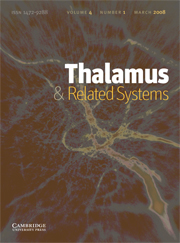No CrossRef data available.
Article contents
The thalamus of the Amazon spiny rat Proechimys guyannensis, an animal model of resistance to epilepsy, and pilocarpine-induced long-term changes of protein expression
Published online by Cambridge University Press: 12 April 2006
Abstract
The thalamus of the spiny rat Proechimys guyannensis (casiragua), a common rodent of the Amazon basin, was investigated with immunohistochemistry, using as markers GABA and glutamic acid decarboxylase, and calcium binding proteins. As in all mammals, GABAergic neurons containing also parvalbumin filled the reticular nucleus, and GABAergic cells were seen in the dorsal lateral geniculate nucleus. At variance with the laboratory rat, GABAergic and parvalbumin-containing neurons were also seen in the laterodorsal and anterodorsal nuclei, in which the two markers were co-distributed. Calbindin-immunopositive cells were widely distributed in dorsal thalamic domains, except for the intralaminar nuclei, and prevailed in the laterodorsal nucleus. The distribution of calretinin-immunopositive neurons was more restricted, and they were especially concentrated in the laterodorsal and midline nuclei.
At variance with the laboratory rat, in which systemic pilocarpine administration induces status epilepticus and results in chronic limbic epilepsy, pilocarpine elicited in casiragua an acute seizure that was not followed by spontaneous seizures up to 1 month, when changes were evaluated in the thalamus using also image analysis. Parvalbumin immunostaining in reticular nucleus neurons and in the dorsal thalamus neuropil, and the number of parvalbumin-positive and GABAergic cells in the laterodorsal and anterodorsal nuclei, exhibited an increase with respect to controls. Calbindin immunostaining was also enhanced, whereas calretinin immunostaining was mostly reduced, but was preserved in midline neurons. The findings show, after an acute seizure induced in an animal model of anti-convulsant mechanisms, regional long-term neurochemical alterations that could reflect functional changes in inhibitory and excitatory thalamic neurons.
Information
- Type
- Research Article
- Information
- Copyright
- 2001 Elsevier Science Ltd

